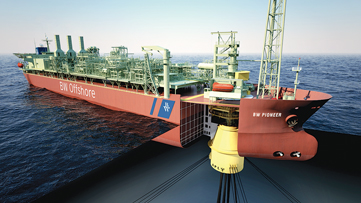What's new in production
First oil from the Gulf of Mexico, last gas from the North Sea
First oil from the Gulf of Mexico, last gas from the North Sea In 2010, two of the world’s most mature offshore regions will take distinctly different paths to achieve resurgence in production. In the North Sea, Statfjord Field will transition from oil to gas production. Oil reserves in the North Sea’s oldest and largest field are declining after having seen as much as 60% of the oil in place recovered. With the change in strategy from oil to gas, Statoil and its partners are planning to increase gas recovery to about 71% from 54% and extend the life of the field. On the other side of the Atlantic, the Gulf of Mexico presents quite a different production scenario. More than 52 years after the first offshore well was drilled out of sight of land, one would think that most of the fields would be in a severe state of decline. Enhanced recovery efforts are underway on the continental shelf, but several intrepid operators have chosen the high-risk strategy of drilling in ultradeep waters of the continental slope and exploring targets as much as 26,000 ft below the ocean floor in search of giant fields. Thus far, more than a dozen major discoveries have been announced in the Lower Tertiary play. In 2010, the first oil from this new frontier will begin flowing from the Perdido spar and the Chinook and Cascade FPSO. Squeezing out the Statfjord. Discovered in 1974, Statfjord Field has been developed with the Statfjord A, B and C production platforms. Statfjord A began production in November 1979, followed by Statfjord B in November 1982 and Statfjord C in June 1985. In a 30-year span, the field has produced oil and gas worth more than $212 billion. Once the oil volume began to decline, the production strategy was to maintain reservoir pressure by injecting produced gas and water. Now, with gas forming 65% of the production stream, a new long-life strategy has been implemented to reduce the reservoir pressure in order to recover large volumes of previously injected gas as well as gas that will be released from the remaining non-recoverable oil. As a part of this strategy, Statoil is installing eight new electrical submersible pumps (ESPs) on the Stat-fjord B platform, and evaluation is underway to install four new ESPs on Statfjord C to pump out water from the reservoir. As a result of this pressure reduction, Statoil expects to produce gas beyond 2020 from the two platforms. The Statfjord A platform will be shut down in 2013. Maxing out the GOM. In its fifth decade of production history, the Gulf of Mexico has opened up a new frontier: the Lower Tertiary play in ultradeep waters stretching from Alaminos Canyon in the Western Gulf to the Keathley Canyon and Walker Ridge areas in the Central Gulf. Focusing on the deepest and oldest rocks, operators have made major discoveries from the Trident by Chevron in 2001 to the Tiber by BP in late 2009. The Tiber discovery well, located in Keathley Canyon Block 102 about 250 mi southeast of Houston, is in 4,132 ft of water. The well was drilled to a total depth of about 35,055 feet, a world record. While much of the Lower Tertiary play is untested, initial potential reserve estimates are as much as 15 billion bbl. Optimal recovery of these discoveries will require the development of a new generation of completion and production technologies to overcome the challenges of extreme high-pressure (> 20,000 psi) and high-temperature (> 400°F) downhole conditions and low-permeability and low-porosity reservoirs. Despite the harsh conditions, production from the Lower Tertiary play will begin in early 2010 from the Perdido spar and later in the year from the Chinook and Cascade facility. A floating production platform with full drill, completion and intervention capability, the Perdido spar will initially produce 100,000 bopd and 200 Mcfgd from Great White, Tobago and Silvertip Fields. Petrobras will be the first company to operate an FPSO in the US Gulf of Mexico, in Cascade and Chinook Fields. The BW Pioneer is scheduled to arrive from Singapore in early 2010. The vessel is capable of processing 80,000 bopd and 17.6 Bcfgd, and can store nearly 500,000 bbl of oil. In the first phase of the project, production from two wells in Cascade Field and one well in Chinook will be connected to the vessel. In the second phase, seven more wells each from Chinook and Cascade may be added. Production is scheduled to go onstream in mid-2010. Discovery and recovery. The discoveries in the Gulf of Mexico and the enhanced recovery in Statfjord Field are complementary processes. New discoveries are still being made in the North Sea, such as Statoil’s Luva Field, and the new fields of the Lower Tertiary play in the GOM will undergo declining production in the next decade and require innovative recovery strategies. What is encouraging to see is that the oil and gas industry retains its spirit of adventure with new discoveries and has the sustaining discipline needed to extract the most value from its productive resources.
|
|||||||||||||
- What's new in production (February 2024)
- Prices and governmental policies combine to stymie Canadian upstream growth (February 2024)
- U.S. operators reduce activity as crude prices plunge (February 2024)
- U.S. producing gas wells increase despite low prices (February 2024)
- U.S. drilling: More of the same expected (February 2024)
- U.S. oil and natural gas production hits record highs (February 2024)
- Applying ultra-deep LWD resistivity technology successfully in a SAGD operation (May 2019)
- Adoption of wireless intelligent completions advances (May 2019)
- Majors double down as takeaway crunch eases (April 2019)
- What’s new in well logging and formation evaluation (April 2019)
- Qualification of a 20,000-psi subsea BOP: A collaborative approach (February 2019)
- ConocoPhillips’ Greg Leveille sees rapid trajectory of technical advancement continuing (February 2019)




